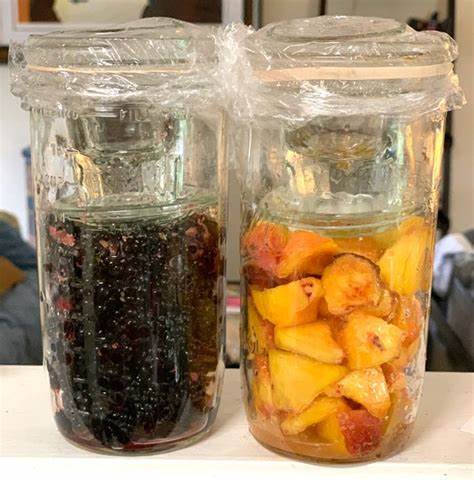When we think of cider, apple-based drinks usually come to mind—especially during fall festivals and at craft breweries. However, the history of cider goes far beyond apples. Long before apples dominated cider-making, people brewed ciders using wild berries and other foraged fruits. These wild berry ciders were a way to preserve nature’s bounty and celebrate local, seasonal ingredients.

Ancient Origins: Fermentation and Wild Berries
Fermentation is an ancient practice, dating back more than 9,000 years. Early humans discovered that fruit, when left to sit, would ferment naturally, turning sugars into alcohol with the help of wild yeasts. Long before apples were cultivated, people used berries and fruits like wild plums, cherries, hawthorn berries, elderberries, and even wild pears to make fermented beverages. These ancient ciders, often called “fruit wines,” blurred the line between cider and wine, as both relied on wild fruits rather than modern, cultivated varieties.
European Traditions: Ciders Made from Wild Berries
In Northern Europe, before apples became the norm for cider-making, people turned to wild berries. Rowan, juniper, and bilberries (a type of wild blueberry) were common ingredients for early ciders. These berries were abundant in the forests and highlands of Scandinavia, Scotland, and the Baltic regions. Juniper berries, known for their medicinal properties, were especially valued. They were often fermented into rustic ciders used in ceremonial and healing practices.
Bilberries and other berries were harvested in late summer and early autumn in places like England and Ireland. These wild berry ciders had earthy, slightly tart flavors and were rich in nutrients. Rowan berries, despite their bitterness, were often sweetened with honey and fermented into mead-cider hybrids that were enjoyed throughout the medieval period.
Celtic and Slavic Wild Berry Ciders
Celtic and Slavic cultures also embraced the use of berries in cider-making. In Ireland and Wales, where apples were less common, wild crabapples, blackberries, and elderberries were fermented to create hearty beverages. Elderberry cider, with its deep purple color and tart flavor, was especially popular. It was often sweetened with honey to balance the tartness, creating a drink that was both nutritious and refreshing.
In Slavic regions, berries like black currants, cherries, and raspberries were used to make rich, flavorful ciders. In Poland, for instance, cherry cider, known as wiśniak, became a favorite drink of the nobility in the medieval era. The widespread availability of berries in Eastern European forests meant that wild berry ciders were an important part of daily life, especially when grain for beer was in short supply.
Native American Wild Berry Fermentation
In North America, before European colonization, indigenous peoples fermented native berries to create traditional beverages. In the Pacific Northwest, berries like huckleberries and salal berries were commonly fermented. These native berries, rich in antioxidants and naturally tart, made refreshing drinks. Fermentation often took place in wooden vessels, and wild yeasts present on the skins of the berries began the fermentation process. While these drinks were not always high in alcohol, they were important for both rituals and daily consumption.
When European settlers arrived, they quickly adopted indigenous fermentation practices. In colonial New England, blackberries, cranberries, and elderberries were often fermented with maple syrup to create regional versions of cider. Using berries and local fruits continued to shape cider-making traditions in early America.
The Modern Revival of Wild Berry Ciders
Today, the tradition of fermenting is making a comeback. With the rise of craft brewing and foraging, many people are rediscovering the art of wild berry cider-making and homemade Kombucha. Ciders made from blackberries, chokecherries, serviceberries, and elderberries are becoming popular again. These modern wild berry ciders often take inspiration from ancient recipes but are crafted with contemporary techniques.
Foragers and cider makers are experimenting with blending different berries to create complex flavors—such as blackberry and crabapple cider or elderberry and wild pear cider. Wild yeasts contribute to the unique tartness and earthy flavors that set these wild berry ciders apart from traditional apple ciders. Additionally, these ciders are deeply connected to the local landscape, with each batch reflecting the specific berries and environmental conditions of the region.
Conclusion: A Wild Berry Tradition Rediscovered
The history of cider is as diverse as the berries and fruits that have been used to create it. From elderberry drinks in Celtic cultures to juniper-infused ciders in Scandinavia, wild berry ciders have been a staple for centuries. Today, the revival of wild berry ciders reflects a renewed interest in sustainable, local ingredients and traditional fermentation techniques.
Whether you’re a craft cider enthusiast or a home fermenter, exploring wild berry ciders offers a delicious way to connect with nature and rediscover a long-lost tradition. So next time you think about cider, consider stepping beyond the apple and embracing the world of wild berries—a rich and flavorful piece of history that’s ready to be rediscovered.
Learn how to make a simple wild fermented cider here.